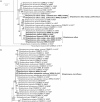Taxonomic evaluation of Streptomyces albus and related species using multilocus sequence analysis and proposals to emend the description of Streptomyces albus and describe Streptomyces pathocidini sp. nov
- PMID: 24277863
- PMCID: PMC4851252
- DOI: 10.1099/ijs.0.058107-0
Taxonomic evaluation of Streptomyces albus and related species using multilocus sequence analysis and proposals to emend the description of Streptomyces albus and describe Streptomyces pathocidini sp. nov
Abstract
In phylogenetic analyses of the genus Streptomyces using 16S rRNA gene sequences, Streptomyces albus subsp. albus NRRL B-1811(T) forms a cluster with five other species having identical or nearly identical 16S rRNA gene sequences. Moreover, the morphological and physiological characteristics of these other species, including Streptomyces almquistii NRRL B-1685(T), Streptomyces flocculus NRRL B-2465(T), Streptomyces gibsonii NRRL B-1335(T) and Streptomyces rangoonensis NRRL B-12378(T) are quite similar. This cluster is of particular taxonomic interest because Streptomyces albus is the type species of the genus Streptomyces. The related strains were subjected to multilocus sequence analysis (MLSA) utilizing partial sequences of the housekeeping genes atpD, gyrB, recA, rpoB and trpB and confirmation of previously reported phenotypic characteristics. The five strains formed a coherent cluster supported by a 100 % bootstrap value in phylogenetic trees generated from sequence alignments prepared by concatenating the sequences of the housekeeping genes, and identical tree topology was observed using various different tree-making algorithms. Moreover, all but one strain, S. flocculus NRRL B-2465(T), exhibited identical sequences for all of the five housekeeping gene loci sequenced, but NRRL B-2465(T) still exhibited an MLSA evolutionary distance of 0.005 from the other strains, a value that is lower than the 0.007 MLSA evolutionary distance threshold proposed for species-level relatedness. These data support a proposal to reclassify S. almquistii, S. flocculus, S. gibsonii and S. rangoonensis as later heterotypic synonyms of S. albus with NRRL B-1811(T) as the type strain. The MLSA sequence database also demonstrated utility for quickly and conclusively confirming that numerous strains within the ARS Culture Collection had been previously misidentified as subspecies of S. albus and that Streptomyces albus subsp. pathocidicus should be redescribed as a novel species, Streptomyces pathocidini sp. nov., with the type strain NRRL B-24287(T).
Figures


References
MeSH terms
Substances
Associated data
- Actions
- Actions
- Actions
- Actions
- Actions
- Actions
- Actions
- Actions
- Actions
- Actions
- Actions
- Actions
- Actions
- Actions
- Actions
- Actions
- Actions
- Actions
- Actions
- Actions
- Actions
- Actions
- Actions
- Actions
- Actions
- Actions
- Actions
- Actions
- Actions
- Actions
- Actions
- Actions
- Actions
- Actions
- Actions
- Actions
- Actions
- Actions
- Actions
- Actions
- Actions
- Actions
- Actions
- Actions
- Actions
- Actions
- Actions
- Actions
- Actions
- Actions
- Actions
- Actions
- Actions
Grants and funding
LinkOut - more resources
Full Text Sources
Other Literature Sources
Molecular Biology Databases

